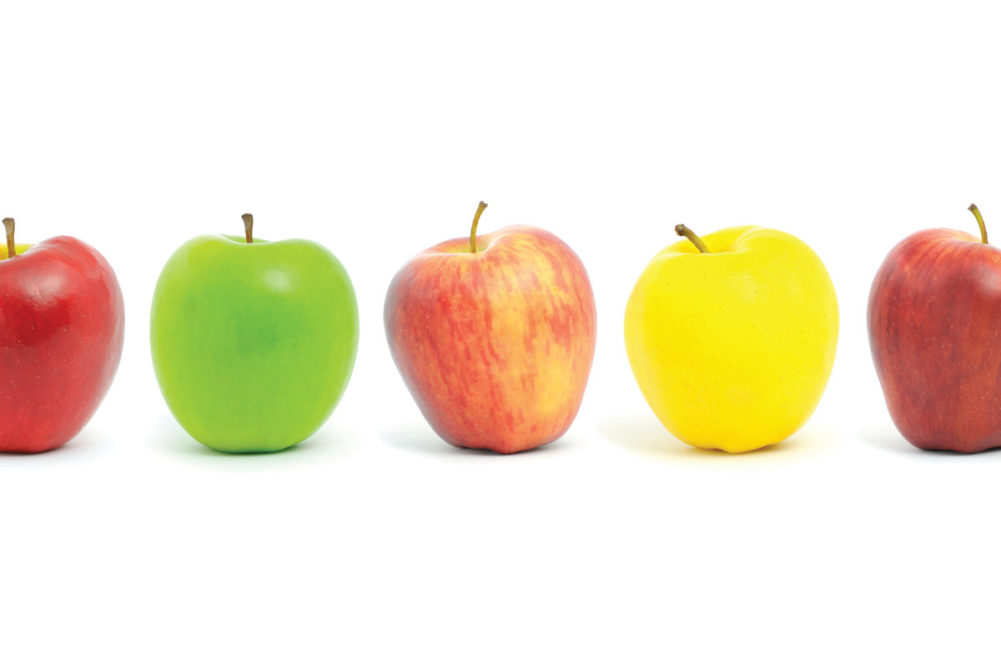KANSAS CITY — Many things go into an effective retail apple marketing campaign.
Building bold displays, refrigerating when possible, frequent rotation, cross-promotion and spotlighting new varieties are good places to start.
And, like all good marketing, be willing to change with the times. For instance, said Chuck Sinks, president of sales and marketing for Yakima, Wash.-based Sage Fruit, there’s been a large shift in promoting branded apple varieties in recent years.
“There used to just be the staples everyone was used to – fuji if you wanted sweet, granny if you want tart, gold if you want to bake,” he said. “Now, there are so many other options for consumers to choose from with a wide range of flavor profiles.”
And don’t forget organic, he added. Increased production of organic varieties has meant year-round availability and a price closer to conventional, giving retailers even more merchandising opportunities in the apple category.
Packaged product also is playing a more important role in how retailers decide to build their apple programs, Sinks said.
In the COVID age, packaged means less exposure to other shoppers when you’re shopping the produce department. They’re also tailor made for grab-and-go and make for a simple online purchase for those consumers going the pick-up or delivery route.
“There was an increase in demand for bagged product over the last year and a half, and while it’s leveling out now, we expect to see a higher number of bags on the shelves than what we would have seen five years ago,” Sinks said. “Pre-packaged products provide a safety barrier for consumers.”
Sage is also tapping into increased demand for nutrition-based messaging. For the 2021-22 season, the company is launching a retail campaign, Good Health in Hand, that highlights the healthy attributes of apples.
The four P’s
Effective retail marketing can be summed up in four words beginning with the same letter, said Brianna Shales, marketing director for Wenatchee, Wash.-based Stemilt Growers: price, placement, promotion, and product.
You could probably throw in a T: timing. Apples need to be in the right place in the produce department at the right time of year, Shales said.
“That means front and center in the fall and wintertime, with big displays and a great mix of varieties and packages,” she said. “October is a big time for large apple promotions because it’s National Apple Month. It’s also important that retailers choose good performers from the array of varieties available and offer a mix that matches with their shopper’s tastes.”
Promotions should be planned twice a month on apples, with multiple varieties on ad at a time instead of singularly focused ads that just don’t bring the category the lift it needs, she added.
Packaged apples are a great way to market to different consumers, Shales said. Stemilt accomplishes that with its kid-focused Lil Snappers 3lb. pouch bag line and 5lb. Apple Lover packs.
Packaging has played a huge role in the evolution of apple retailing over the years, Shales said. Currently, about 40% of apple volume sold in the United States is sold in bags.
“We see apples sold more effectively as everyday items in packages, and the pouch bag has become the norm in recent years while it used to be heavy to poly bags,” she said.
Organic apples in particular have enjoyed recent growth on the packaged side, Shales said. Stemilt has seen double-digit growth in sales of packaged apples over the past year and a half, driven in large part by COVID.
The surge in online sales has also been a boon for packaged product.
“I think packaging will continue to play an important role in apple merchandising now that we are in the omnichannel shopping environment,” Shales said. “Packages move through the supply chain well and shoppers understand exactly what they are buying when choosing them online. It can also help lift the average purchase sizing, bringing a higher ring through the register.”
The onset of new varieties is another way apple retailing has changed, Shales said. Retailers are paying much more attention to merchandising the mix of varieties, including allocating space and setting the mix.
Crunching the numbers
When it comes to marketing apples at retail, Vancouver, B.C.-based Oppy likes to dive deep into the numbers.
“Knowledge is power,” said Roger Aguirre, Oppy’s director of apples and pears. “The most effective way to market apples is within the data. We provide custom analytics to our retail partners based on their own demographics so we can help in identifying the right marketing mix to help them capitalize on the product, place, promotion, price and people.”
Oppy provides its retail partners with what Aguirre calls a “consumer-driven matrix of activity” that’s constantly evolving. Whether it’s traditional marketing, digital campaigns or other forms of marketing, the company is constantly pivoting to the changing needs not only of the consumer but also the retailer.
“The current apple set has changed immensely since I entered the industry years ago,” he said. “Retailers have to be savvy with what works on their shelf and what doesn’t. We’re here to help them in their SKU rationalization to provide top-notch products that will keep their customers coming back for more.”
Oppy also saw a big uptick in packaged sales during the pandemic, and Aguirre is optimistic about the future prospects for bagged.
“It holds a really exciting opportunity in meeting the needs we have for different apple sizing."
This was featured in the September issue of Supermarket Perimeter. Check out our digital edition for more from this issue.

